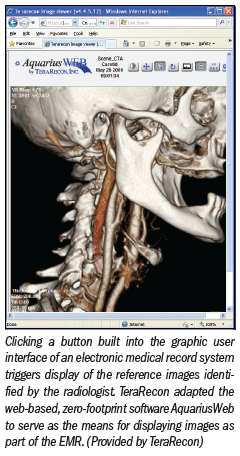TeraRecon harnesses cloud to display EMR images
TeraRecon's zero-footprint web viewer has been around for a couple of years, but now it’s getting a new mission: to slip images into the electronic medical record.
TeraRecon's zero-footprint web viewer has been around for a couple of years, but now it’s getting a new mission: to slip images into the electronic medical record.
Using the company’s AquariusWeb, images seen on TeraRecon’s thinclient advanced visualization system, iNtuition, can be “published” into a patient’s EMR using the Internet as a conduit.
The web viewer is built into the graphic user interface of the EMR. Clicking this button when viewing a patient’s record triggers display of the reference images selected by the radiologist to illustrate the case.
The images appear in the context of the report, according to Jeff Sorenson, TeraRecon vice president of Aquarius sales USA and Canada, but they are not actually in the report. Instead, they reside in the Aquarius server.
“By launching a zero-footprint web viewer, we provide the links that allow physicians to view images on their current products without a forklift redeployment,” Sorenson said.
The software works like browser- based functions, such as Google Maps. No software needs to be downloaded to the PC yet images can be displayed. In this way, the report stays small in data size, yet offers the images that help a referring physician better understand the radiologist’s findings.

This new capability is part of TeraRecon’s effort to leverage cloud computing, an effort that took shape most obviously this spring with the debut of iNtuition Cloud, the company’s flagship iNtuition solution in “Software as a Service” form.
iNtuition Cloud offers much more than just the display of preselected images. Aquarius applications are accessible through a web browser with SSL security and the AquariusWeb zero-footprint web viewer.
Registered users are granted a unique, secure account login, to which they can upload DICOM data using TeraRecon’s secure upload portal. This triggers advanced preprocessing by the AquariusAPS server in the cloud to prepare the data for interpretation and review using TeraRecon’s workflow templates, which are driven by the AquariusAPS automation. These automated functions precalculate centerlines, apply image filters (such as optimizations for low-dose scanning), remove bones, and identify anatomical landmarks.
This scalable cloud-based iNtuition platform is possible thanks to technology that ensures the secure upload of imaging data. The EMR-embedded technology depends on the same technology to securely upload images.
Like iNtuition Cloud, the EMR version can be securely opened for review in any compatible web browser from any computer with an appropriate Internet connection. But it is a “Cloud-lite” version, simpler in both form and function.
In this, the radiologist has already processed images, identifying ones that were integral to the final diagnosis. These key images are then “published” so they can be seen as part of the electronic medical record.
“But the data don’t have to be comingled (with data in an EMR),” Sorenson said. “It’s a simple concept and technologically not difficult for TeraRecon.”
Emerging AI Algorithm Shows Promise for Abbreviated Breast MRI in Multicenter Study
April 25th 2025An artificial intelligence algorithm for dynamic contrast-enhanced breast MRI offered a 93.9 percent AUC for breast cancer detection, and a 92.3 percent sensitivity in BI-RADS 3 cases, according to new research presented at the Society for Breast Imaging (SBI) conference.
The Reading Room Podcast: Current Perspectives on the Updated Appropriate Use Criteria for Brain PET
March 18th 2025In a new podcast, Satoshi Minoshima, M.D., Ph.D., and James Williams, Ph.D., share their insights on the recently updated appropriate use criteria for amyloid PET and tau PET in patients with mild cognitive impairment.
Can Abbreviated Breast MRI Have an Impact in Assessing Post-Neoadjuvant Chemotherapy Response?
April 24th 2025New research presented at the Society for Breast Imaging (SBI) conference suggests that abbreviated MRI is comparable to full MRI in assessing pathologic complete response to neoadjuvant chemotherapy for breast cancer.
Clarius Mobile Health Unveils Anterior Knee Feature for Handheld Ultrasound
April 23rd 2025The T-Mode Anterior Knee feature reportedly offers a combination of automated segmentation and real-time conversion of grayscale ultrasound images into color-coded visuals that bolster understanding for novice ultrasound users.